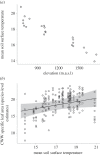Intraspecific trait variation and changing life-history strategies explain host community disease risk along a temperature gradient
- PMID: 36744568
- PMCID: PMC9900715
- DOI: 10.1098/rstb.2022.0019
Intraspecific trait variation and changing life-history strategies explain host community disease risk along a temperature gradient
Abstract
Predicting how climate change will affect disease risk is complicated by the fact that changing environmental conditions can affect disease through direct and indirect effects. Species with fast-paced life-history strategies often amplify disease, and changing climate can modify life-history composition of communities thereby altering disease risk. However, individuals within a species can also respond to changing conditions with intraspecific trait variation. To test the effect of temperature, as well as inter- and intraspecifc trait variation on community disease risk, we measured foliar disease and specific leaf area (SLA; a proxy for life-history strategy) on more than 2500 host (plant) individuals in 199 communities across a 1101 m elevational gradient in southeastern Switzerland. There was no direct effect of increasing temperature on disease. Instead, increasing temperature favoured species with higher SLA, fast-paced life-history strategies. This effect was balanced by intraspecific variation in SLA: on average, host individuals expressed lower SLA with increasing temperature, and this effect was stronger among species adapted to warmer temperatures and lower latitudes. These results demonstrate how impacts of changing temperature on disease may depend on how temperature combines and interacts with host community structure while indicating that evolutionary constraints can determine how these effects are manifested under global change. This article is part of the theme issue 'Infectious disease ecology and evolution in a changing world'.
Keywords: climate change; disease; elevation; functional traits; intraspecific trait variation.
Figures





Similar articles
-
The effect of host community functional traits on plant disease risk varies along an elevational gradient.Elife. 2021 May 13;10:e67340. doi: 10.7554/eLife.67340. Elife. 2021. PMID: 33983120 Free PMC article.
-
Trait-Based Community Assembly along an Elevational Gradient in Subalpine Forests: Quantifying the Roles of Environmental Factors in Inter- and Intraspecific Variability.PLoS One. 2016 May 18;11(5):e0155749. doi: 10.1371/journal.pone.0155749. eCollection 2016. PLoS One. 2016. PMID: 27191402 Free PMC article.
-
Intraspecific trait variability shapes leaf trait response to altered fire regimes.Ann Bot. 2021 Mar 24;127(4):543-552. doi: 10.1093/aob/mcaa179. Ann Bot. 2021. PMID: 33038232 Free PMC article.
-
Intraspecific genetic variation and species coexistence in plant communities.Biol Lett. 2016 Jan;12(1):20150853. doi: 10.1098/rsbl.2015.0853. Biol Lett. 2016. PMID: 26790707 Free PMC article. Review.
-
A global meta-analysis of the relative extent of intraspecific trait variation in plant communities.Ecol Lett. 2015 Dec;18(12):1406-19. doi: 10.1111/ele.12508. Epub 2015 Sep 28. Ecol Lett. 2015. PMID: 26415616 Review.
Cited by
-
Infectious disease ecology and evolution in a changing world.Philos Trans R Soc Lond B Biol Sci. 2023 Mar 27;378(1873):20220002. doi: 10.1098/rstb.2022.0002. Epub 2023 Feb 6. Philos Trans R Soc Lond B Biol Sci. 2023. PMID: 36744560 Free PMC article. No abstract available.
References
-
- Pachauri RK, et al. 2014. Climate change 2014: synthesis report. In Contribution of Working Groups I, II and III to the fifth assessment report of the Intergovernmental Panel on Climate Change. Geneva, Switzerland: IPCC.
-
- McNew GL. 1960. The nature, origin, and evolution of parasitism. In Plant pathology: an advanced treatise (eds Horsfall JG, Dimond AE), pp. 1-48. New York, NY and London, UK: Academic Press.
Publication types
MeSH terms
Associated data
LinkOut - more resources
Full Text Sources

